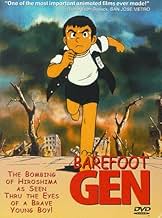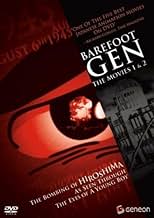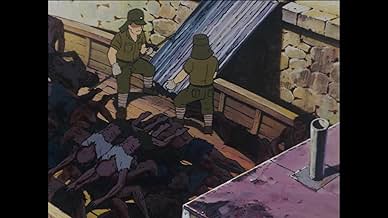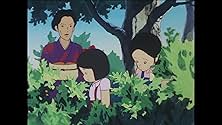VALUTAZIONE IMDb
8,0/10
9829
LA TUA VALUTAZIONE
Segui l'effetto della bomba atomica sulla vita di un ragazzo e sulla vita del popolo giapponese.Segui l'effetto della bomba atomica sulla vita di un ragazzo e sulla vita del popolo giapponese.Segui l'effetto della bomba atomica sulla vita di un ragazzo e sulla vita del popolo giapponese.
- Regia
- Sceneggiatura
- Star
- Premi
- 1 vittoria in totale
Issei Miyazaki
- Gen
- (voce)
Catherine Battistone
- Gen (1995)
- (English version)
- (voce)
Yoshie Shimamura
- Kimie
- (voce)
Iona Morris
- Kimie (1995)
- (English version)
- (voce)
Masaki Kôda
- Shinji
- (voce)
- …
Brianne Brozey
- Shinji (1995)
- (English version)
- (voce)
- (as Brianne Siddal)
Barbara Goodson
- Ryuta (1995)
- (English version)
- (voce)
Takao Inoue
- Daikichi
- (voce)
Kirk Thornton
- Daikichi (1995)
- (English version)
- (voce)
- (as Kurk Thornton)
Seiko Nakano
- Eiko
- (voce)
Wendee Lee
- Eiko (1995)
- (English version)
- (voce)
Takeshi Aono
- Eizo
- (voce)
Michael McConnohie
- Eizo
- (English version)
- (voce)
- (as Amike McConnohie)
- …
Katsuji Mori
- Seiji
- (voce)
Taeko Nakanishi
- Hana
- (voce)
Junji Nishimura
- Pak
- (voce)
Ardwight Chamberlain
- Pak
- (English version)
- (voce)
- …
Recensioni in evidenza
This is the sort of movie that I would rate up there with Schindler's list. Its haunting and powerful. This is also the sort of movie that I feel that every history teacher who teaches American History should show their students at some point in time. While some of the scenes do get a bit annoying, it still brings home the horrors of what occurred at the end of World War II. The other thing is the point of view, which was not "anti American" and doesn't try and place blame, which makes this all the more powerful.
Barefoot Gen is the autobiographical story of manga artist, Keiji Nakazawa and his experience during the times of the Hiroshima bombings in 1942. What ensues is something so unbelievable, so gritty, so real, it will change your life forever.
The film is adapted as an anime from Keiji's short manga series depicting all that he experienced just at the age of six when the bombings hit. His story truly is one of the most amazing things you will ever hear. Nothing else in film has ever captured the effects of the bombings in such a real and emotional way. It shows the viewers what really did happen and what we were never told. It shows us how real the bombings really were as we follow Gen through his struggle for survival during Japan's darkest hours.
If you haven't seen this film, you are missing out. While the film does not hold back on the gritty details, and what happens to the people of Japan throughout the whole of the film is very horrifying, you cannot miss this film due to these aspects. It's these things that make it so real and it would be a tragedy to ignore this film. It opened my eyes to what really went down in Hiroshima and I almost felt personally affected. During my whole time watching this film, I kept finding myself in disbelief that something like this actually occurred in our history, and recently at that. I mean, a whole society was rebuilt on the effects of the bombings and once again shows us how very, very wrong war is. One of the best films I have ever seen.
9.5/10 Hamish Kearvell A.K.A Screaming Japan Productions - www.myspace.com/screamingjapanproductions
The film is adapted as an anime from Keiji's short manga series depicting all that he experienced just at the age of six when the bombings hit. His story truly is one of the most amazing things you will ever hear. Nothing else in film has ever captured the effects of the bombings in such a real and emotional way. It shows the viewers what really did happen and what we were never told. It shows us how real the bombings really were as we follow Gen through his struggle for survival during Japan's darkest hours.
If you haven't seen this film, you are missing out. While the film does not hold back on the gritty details, and what happens to the people of Japan throughout the whole of the film is very horrifying, you cannot miss this film due to these aspects. It's these things that make it so real and it would be a tragedy to ignore this film. It opened my eyes to what really went down in Hiroshima and I almost felt personally affected. During my whole time watching this film, I kept finding myself in disbelief that something like this actually occurred in our history, and recently at that. I mean, a whole society was rebuilt on the effects of the bombings and once again shows us how very, very wrong war is. One of the best films I have ever seen.
9.5/10 Hamish Kearvell A.K.A Screaming Japan Productions - www.myspace.com/screamingjapanproductions
9cpto
The story is excellent, the animation effective, but the lack of in-between frames is intrusive in spots. For the full story, read the graphic novels. They provide an even more effective tale.
As with Nosaka's "Grave of the Fireflies," Gen deals with a Japanese youth in the waning days of WW II. The first 30 minutes shows him to be typical for his stage of life, swinging between a self-centered boy and an adult. He is suddenly thrust into the position of head of the family after the Hiroshima bomb kills his father, brother, and sister, and destroys the city. The remainder of the movie deals with his transformation into an adult, with adult sensibilities and adult responsibilities.
Gen is clearly a Japanese story - the author, Nakazawa, lived through the event as a child. But the story could have taken place in Dresden or London just as easily. Although the atomic bomb is the event the movie revolves around, the story is really about the people - the children - and the effect the event has on their lives.
It's too bad that so much of the books had to be sacrificed to the time limits of a film. The novels delve much more deeply into the cruel society that Japan was in the 1940s. For example, much more was made of the neighbor's Korean background in the book; in the movie, you wouldn't realize the ethnicity if you didn't think about the name.
As a conventional film, Gen would probably be too honest to find real appeal in the U.S. Worse, the animation format will probably dissuade those who would otherwise see and appreciate it. Like most Japanese anime, this is not a "cartoon." It is a serious film in an unconventional - for the U.S. - medium.
The DVD transfer is excellent and belongs in your collection. This is a movie that continues to educate and enlighten with each viewing.
As with Nosaka's "Grave of the Fireflies," Gen deals with a Japanese youth in the waning days of WW II. The first 30 minutes shows him to be typical for his stage of life, swinging between a self-centered boy and an adult. He is suddenly thrust into the position of head of the family after the Hiroshima bomb kills his father, brother, and sister, and destroys the city. The remainder of the movie deals with his transformation into an adult, with adult sensibilities and adult responsibilities.
Gen is clearly a Japanese story - the author, Nakazawa, lived through the event as a child. But the story could have taken place in Dresden or London just as easily. Although the atomic bomb is the event the movie revolves around, the story is really about the people - the children - and the effect the event has on their lives.
It's too bad that so much of the books had to be sacrificed to the time limits of a film. The novels delve much more deeply into the cruel society that Japan was in the 1940s. For example, much more was made of the neighbor's Korean background in the book; in the movie, you wouldn't realize the ethnicity if you didn't think about the name.
As a conventional film, Gen would probably be too honest to find real appeal in the U.S. Worse, the animation format will probably dissuade those who would otherwise see and appreciate it. Like most Japanese anime, this is not a "cartoon." It is a serious film in an unconventional - for the U.S. - medium.
The DVD transfer is excellent and belongs in your collection. This is a movie that continues to educate and enlighten with each viewing.
10juubei-2
If you haven't seen this film, make it a top priority to track it down.
Barefoot Gen, the animated version of the autobiographical manga by Keiji Nakazawa, is an unflinching first-hand look at the result of dropping an atomic bomb on a civilian target. Comparisons to Grave of the Fireflies will abound, but for me personally Barefoot Gen was the more moving of the two. Though it centers on the effects of the atom bomb, the fact is this could be about any war, and any people. It is a story for all of humanity.
Barefoot Gen is filled with its fair share of caricatured mannerisms, but calling it a dramedy is pushing it. There isn't much to laugh at and even when the characters act a little over-the-top, the overall effect hits its mark (strongly). What makes the story even more powerful is knowing it comes from a survivor of the attack, and the honesty with which the film doles out darker and darker shades of life in the aftermath of the bombing (including subtle things one might not think about).
I think this along with Grave of the Fireflies belongs in every collection, even if you will only watch it once or twice, if only to show it to future generations. Its one thing to see a big explosion relating to the a-bomb in almost every other anime, but its another thing entirely to see the reality of it, and its aftermath.
At the risk of sounding incredibly pretentious, it made me want to burn flags. Not just from one country, but from all countries... to put it another way, I wish we could be united by our common humanity.
Barefoot Gen, the animated version of the autobiographical manga by Keiji Nakazawa, is an unflinching first-hand look at the result of dropping an atomic bomb on a civilian target. Comparisons to Grave of the Fireflies will abound, but for me personally Barefoot Gen was the more moving of the two. Though it centers on the effects of the atom bomb, the fact is this could be about any war, and any people. It is a story for all of humanity.
Barefoot Gen is filled with its fair share of caricatured mannerisms, but calling it a dramedy is pushing it. There isn't much to laugh at and even when the characters act a little over-the-top, the overall effect hits its mark (strongly). What makes the story even more powerful is knowing it comes from a survivor of the attack, and the honesty with which the film doles out darker and darker shades of life in the aftermath of the bombing (including subtle things one might not think about).
I think this along with Grave of the Fireflies belongs in every collection, even if you will only watch it once or twice, if only to show it to future generations. Its one thing to see a big explosion relating to the a-bomb in almost every other anime, but its another thing entirely to see the reality of it, and its aftermath.
At the risk of sounding incredibly pretentious, it made me want to burn flags. Not just from one country, but from all countries... to put it another way, I wish we could be united by our common humanity.
I've basically pasted this from wikipedia, but since the autobiographical element to this story wasn't mentioned I thought I should post it. There is an interesting article with the artist here http://www.tcj.com/256/i_nakazawa.html (中沢 啓治, Keiji Nakazawa, born 1939) is a Japanese manga artist and writer.
He was born in Hiroshima, and was in the city when it was destroyed by an atomic bomb in 1945. All of his family members who had not been evacuated died in the bombing except for his mother, and an infant sister who died several weeks after the bombing.
In 1961, Nakazawa moved to Tokyo to become a full-time cartoonist, and produced short pieces for manga anthologies such as Shonen Gaho, Shonen King, and Bokura.
In 1966, following the death of his mother, Nakazawa returned to his memories of the destruction of Hiroshima and began to express them in his stories. Kuroi Ame ni Utarete (Struck by Black Rain), the first of a series of five books, was a fictional story of Hiroshima survivors involved in the postwar black market. In 1972, Nakazawa chose to portray his own experience directly in the story "Ore wa Mita" ("I Saw It"), published in Monthly Shonen Jump (In 1982, the story was translated into English and published as a one-shot comic book by Educomics as "I Saw It").
Immediately after finishing "I Saw It", Nakazawa began his major work, Hadashi no Gen (Barefoot Gen). This series, which eventually filled ten volumes (six volumes in English translation), was based on the same events as "I Saw It" but fictionalized, with the young Gen as a stand-in for the author. Barefoot Gen depicted the bombing and its aftermath in graphic detail, but also turned a critical eye on the militarization of Japanese society in the World War II years, and on the sometimes abusive dynamics of the traditional family. Barefoot Gen was made into an animated film, released in 1983. It was followed three years later by a sequel.
He was born in Hiroshima, and was in the city when it was destroyed by an atomic bomb in 1945. All of his family members who had not been evacuated died in the bombing except for his mother, and an infant sister who died several weeks after the bombing.
In 1961, Nakazawa moved to Tokyo to become a full-time cartoonist, and produced short pieces for manga anthologies such as Shonen Gaho, Shonen King, and Bokura.
In 1966, following the death of his mother, Nakazawa returned to his memories of the destruction of Hiroshima and began to express them in his stories. Kuroi Ame ni Utarete (Struck by Black Rain), the first of a series of five books, was a fictional story of Hiroshima survivors involved in the postwar black market. In 1972, Nakazawa chose to portray his own experience directly in the story "Ore wa Mita" ("I Saw It"), published in Monthly Shonen Jump (In 1982, the story was translated into English and published as a one-shot comic book by Educomics as "I Saw It").
Immediately after finishing "I Saw It", Nakazawa began his major work, Hadashi no Gen (Barefoot Gen). This series, which eventually filled ten volumes (six volumes in English translation), was based on the same events as "I Saw It" but fictionalized, with the young Gen as a stand-in for the author. Barefoot Gen depicted the bombing and its aftermath in graphic detail, but also turned a critical eye on the militarization of Japanese society in the World War II years, and on the sometimes abusive dynamics of the traditional family. Barefoot Gen was made into an animated film, released in 1983. It was followed three years later by a sequel.
Lo sapevi?
- QuizThe author of the "Barefoot Gen" manga, Keiji Nakazawa, said that 70% of the story is based on true events from his experience of the atomic bombing of Hiroshima.
- BlooperWhen Gen and Shinji take a big bite from a sweet potato from each end, they are then told by Eiko to give the sweet potato to their mother. Once the sweet potato is given to her, it is whole again.
- Citazioni
Daikichi Nakaoka: This war can't be right. But it's only the cowards like me who dare say it. If there were only a few more like us. You know, sometimes it takes more courage not to fight than to fight, to not want to kill when all around you are calling out for blood. That's real courage in my book. If you boys remember nothing else I teach you, I hope you'll remember that.
- Curiosità sui creditiThe closing credits run horizontally from the left side. Above the credits is footage of a paper boat lantern built sailing past multiple lanterns. After the boat has slowly vanished, the lanterns slowly turn into stars.
- Versioni alternativeThere's a slightly different version of the movie on the website Rumble. Only one change has been applied to it which is the cut to the scene where Kimie (Gen's mom) finds a dead woman on the forest.
- ConnessioniFeatured in Gen di Hiroshima 2 (1986)
I più visti
Accedi per valutare e creare un elenco di titoli salvati per ottenere consigli personalizzati
- How long is Barefoot Gen?Powered by Alexa
Dettagli
Contribuisci a questa pagina
Suggerisci una modifica o aggiungi i contenuti mancanti






























